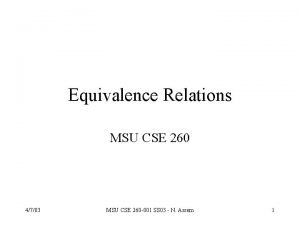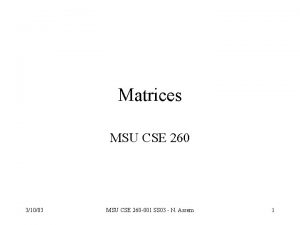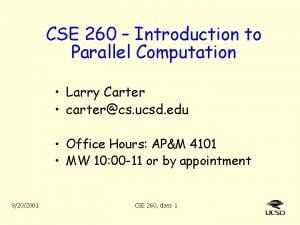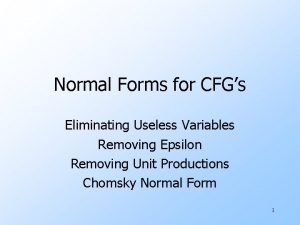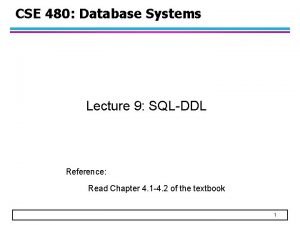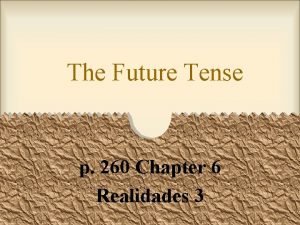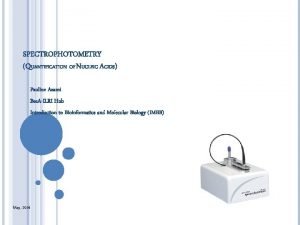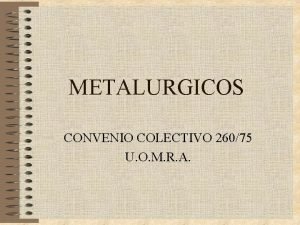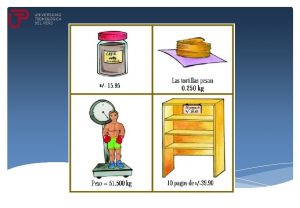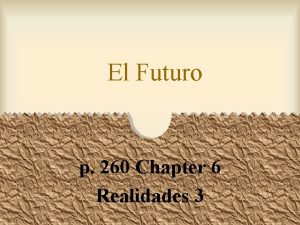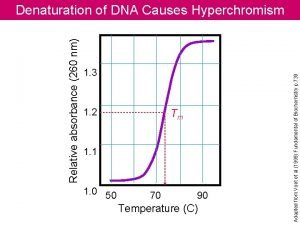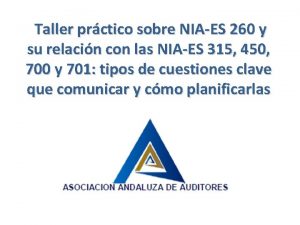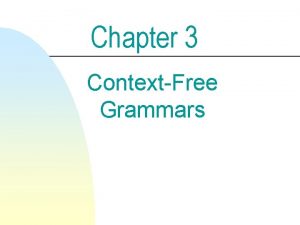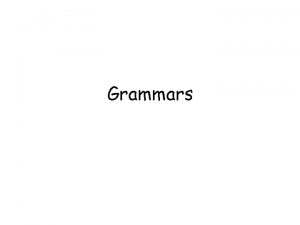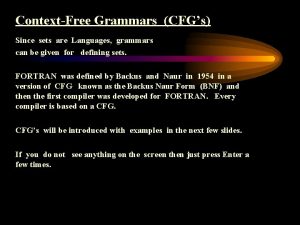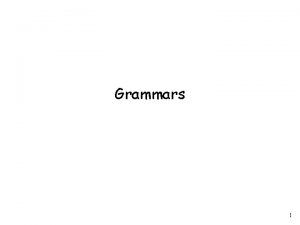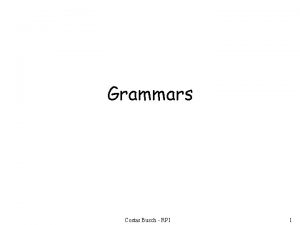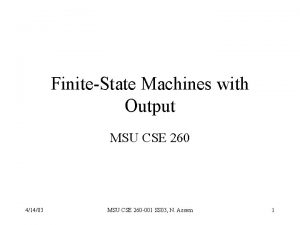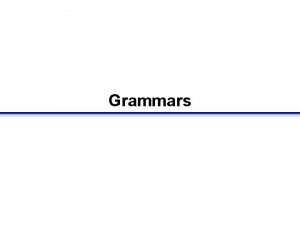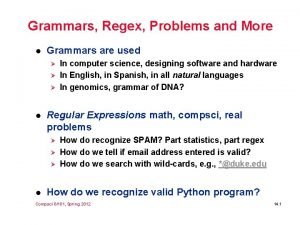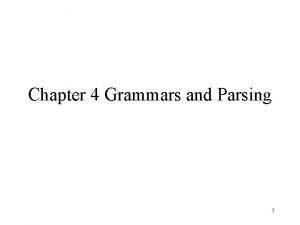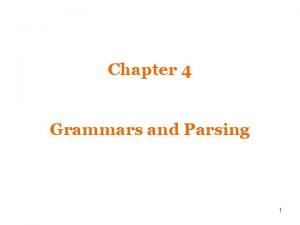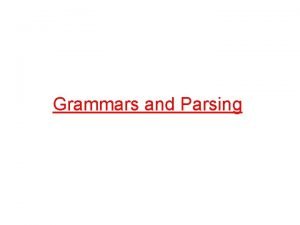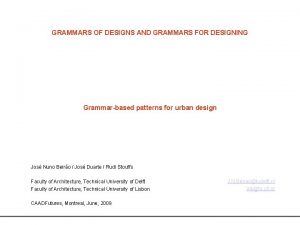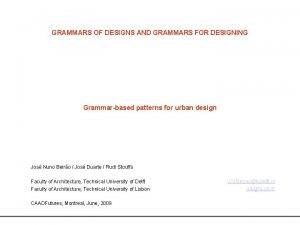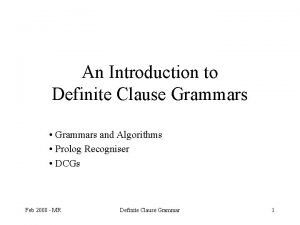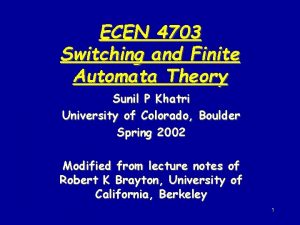Languages and Grammars MSU CSE 260 4703 MSU
























- Slides: 24

Languages and Grammars MSU CSE 260 4/7/03 MSU CSE 260 -001 SS 03 - N. Assem 1

Outline • Introduction: Example • Phrase-Structure Grammars: Terminology, Definition, Derivation, Language of a Grammar, Examples – Exercise 10. 1 (1) • Types of Phrase-Structure Grammars • Derivation Trees: Example, Parsing – Exercise 10. 1 (2, 3) • Backus-Naur Form 4/7/03 MSU CSE 260 -001 SS 03 - N. Assem 2

Introduction • In the English language, the grammar determines whether a combination of words is a valid sentence. • Are the following valid sentences? – The large rabbit hops quickly. – The frog writes neatly. – Swims quickly mathematician. Yes No • Grammars are concerned with the syntax (form) of a sentence, and NOT its semantics (or meaning. ) 4/7/03 MSU CSE 260 -001 SS 03 - N. Assem 3

English Grammar • Sentence: noun phrase followed by verb phrase; • Noun phrase: article adjective noun, or article noun; • Verb phrase: verb adverb, or verb; • Article: a, or the; • Adjective: large, or hungry; • Noun: rabbit, or mathematician, or frog; • Verb: eats, or hops, or writes, or swims; • Adverb: quickly, or wildly, or neatly; 4/7/03 MSU CSE 260 -001 SS 03 - N. Assem 4

Example • • • Sentence Noun phrase verb phrase Article adjective noun verb adverb the large rabbit verb adverb the large rabbit hops quickly 4/7/03 MSU CSE 260 -001 SS 03 - N. Assem 5

Grammars and Computation • Grammars are used as a model of computation. • Grammars are used to: – generate the words of a language, and – determine whether a word is in a language. 4/7/03 MSU CSE 260 -001 SS 03 - N. Assem 6

Phrase-Structure Grammars Terminology • Definitions. A vocabulary (or alphabet) V is a finite, nonempty set of elements called symbols. • A word (or sentence) over V is a string of finite length of elements of V. • The empty string (or null string, ) denoted by , is the string containing no symbols. • The set of all words over V is denoted by V*. • A language over V is a subset of V*. 4/7/03 MSU CSE 260 -001 SS 03 - N. Assem 7

Phrase-Structure Grammars • A language can be specified by: – listing all the words in the language, or – giving a set of criteria satisfied by its words, or – using a grammar. • A grammar provides: – a set of symbols, and – a set of rules, called productions, for producing words by replacing strings by other strings: w 0 w 1. 4/7/03 MSU CSE 260 -001 SS 03 - N. Assem 8

Phrase-Structure Grammar Definition A phrase-structure grammar G = (V, T, S, P) consists of: – a vocabulary V, – a subset T of V consisting of terminal elements, – a start symbol S from V, and – a set P of productions. The set N = V-T consists of nonterminal symbols. Every production in P must contain at least one nonterminal on its left side. 4/7/03 MSU CSE 260 -001 SS 03 - N. Assem 9

Phrase-structure Grammar Example • G = {V, T, S, P}, where – V = {a, b, A, B, S}, – T = {a, b}, – S is the start symbol, and – P = { S Aba, A BB, B ab, AB b}. 4/7/03 MSU CSE 260 -001 SS 03 - N. Assem 10

Phrase-Structure Grammars Derivation • Definition. Let G = (V, T, S, P) be a phrase-structure grammar. Let w 0 = lz 0 r and w 1 = lz 1 r be strings over V. – If z 0 z 1 is a production of G, we say that: w 1 is directly derivable from w 0 (denoted: w 0 w 1. ) – If w 0, w 1, …, wn are strings over V such that: w 0 w 1, w 1 w 2, …, wn-1 wn, we say that: wn is derivable from w 0 (denoted: w 0 * wn. ) Note. * should be on top of . – The sequence of all steps used to obtain wn from w 0 is called a derivation. 4/7/03 MSU CSE 260 -001 SS 03 - N. Assem 11

Example • In the previous example grammar, the production: B ab makes the string Aaba directly derivable from string ABa. – ABa Aaba • Also Aaba BBaba Babababa – using: A BB, B ab, and B ab. • So: ABa * abababa Øabababa is derivable from ABa. 4/7/03 MSU CSE 260 -001 SS 03 - N. Assem 12

Language of a Grammar • Definition. Let G = (V, T, S, P) be a phrase-structure grammar. The language generated by G (or the language of G), denoted by L(G), is the set of all strings of terminals that are derivable from the start symbol S. L(G) = {w T* | S * w}. 4/7/03 MSU CSE 260 -001 SS 03 - N. Assem 13

Example • Let G = {V, T, S, P} be the grammar where: – V = {S, 0, 1}, – T = {0, 1}, – P = { S 11 S, S 0}. • What is L(G)? – At any stage of the derivation we can either: • add two 1 s at the end of the string, or • terminate the derivation by adding a 0 at the end of the string. – L(G)={0, 11110, 1111110, …} = Set of all strings that begin with an even number of 1 s and end with 0. 4/7/03 MSU CSE 260 -001 SS 03 - N. Assem 14

Exercise 10. 1 (1) 4/7/03 MSU CSE 260 -001 SS 03 - N. Assem 15

Types of Grammars • A type 0 (phrase-structure) grammar has no restrictions on its productions. • A type 1 (or context-sensitive) grammar has productions only of forms: – w 1 w 2 with length of w 2 length of w 1, or – w 1 . • A type 2 (or context-free) grammar has productions only of the form A w 2, where A is a single nonterminal symbol. 4/7/03 MSU CSE 260 -001 SS 03 - N. Assem 16

Types of Grammars – cont. • A type 3 (or regular) grammar has productions only of the form: – A a. B, or A a, where • A and B are nonterminal symbols, and • a is a terminal symbol, or – S . • Note. – Every type 3 grammar is a type 2 grammar – Every type 2 grammar is a type 1 grammar – Every type 1 grammar is a type 0 grammar 4/7/03 MSU CSE 260 -001 SS 03 - N. Assem 17

Types of Grammars - Summary Type 0 1 2 3 4/7/03 Restrictions on productions w 1 w 2 No restrictions l(w 1) l(w 2), or w 2= w 1=A where A N w 1=A, and w 2=a. B or w 2=a, where A N, B N, a T, or w 1=S and w 2= MSU CSE 260 -001 SS 03 - N. Assem 18

Derivation Trees • For type 2 (context-free) grammars: A derivation (or parse) tree, is an ordered rooted tree that represents a derivation in the language generated by a context-free grammar, where: – – 4/7/03 the root represents the starting symbol; the internal vertices represent nonterminal symbols; the leaves represent the terminal symbols; for a production A w, the vertex representing A will have children vertices that represent each symbol in w. MSU CSE 260 -001 SS 03 - N. Assem 19

Example • Derivation tree for: the hungry rabbit eats quickly sentence noun phrase verb phrase article adjective noun verb adverb the hungry rabbit eats quickly 4/7/03 MSU CSE 260 -001 SS 03 - N. Assem 20

Exercise 10. 1 (2, 3) 4/7/03 MSU CSE 260 -001 SS 03 - N. Assem 21

Parsing • To determine whether a string is in the language generated by a grammar, use: – Top-down parsing: • Begin with S and attempt to derive the word by successively applying productions, or – Bottom-up parsing: • Work backward: Begin by inspecting the word and apply productions backward. 4/7/03 MSU CSE 260 -001 SS 03 - N. Assem 22

Example • Let G = {V, T, S, P} be the grammar where: 4/7/03 – V = {a, b, c, A, B, C, S}, T = {a, b, c}, – Productions: Determine whether cbab is in L(G)? S AB Top-down parsing: A Ca S AB B Ba S AB Ca. B B Cb S AB Ca. B cba. B B b S AB Ca. B cbab C cb Bottom-up parsing: C b Cab cbab Ab Cab cbab AB Ab Cab cbab S AB Ab Cab cbab MSU CSE 260 -001 SS 03 - N. Assem 23

Backus-Naur Form • Used with type 2 (context-free) grammars; like for specification of programming languages: – Use : : = instead of – Enclose nonterminal symbols within < > – Group productions with same left side with symbol | • Example. – – 4/7/03 <signed integer> : : = <sign><integer> <sign> : : = + | <integer> : : = <digit> | <digit><integer> <digit> : : = 0 | 1 | 2 | 3 | 4 | 5 | 6 | 7 | 8 | 9 MSU CSE 260 -001 SS 03 - N. Assem 24
 Equivalence class
Equivalence class Cse 260 msu
Cse 260 msu Msu cse 260
Msu cse 260 Which grammar generates regular language
Which grammar generates regular language Ucsd cse260
Ucsd cse260 What is unrestricted grammar
What is unrestricted grammar Questions on context free grammar
Questions on context free grammar Useless variables in context-free grammars
Useless variables in context-free grammars Type 0 grammar is called unrestricted grammar
Type 0 grammar is called unrestricted grammar Cse 435 msu
Cse 435 msu Cse 480 msu
Cse 480 msu Adam doupe cse 340
Adam doupe cse 340 Vineeth kashyap
Vineeth kashyap Pasar in future tense
Pasar in future tense 260/280 ratio
260/280 ratio 260/75
260/75 Dos cajas de galletas contienen en total 260 galletas
Dos cajas de galletas contienen en total 260 galletas El futuro (p. 260)
El futuro (p. 260) Ed 260
Ed 260 Chem 260 umich
Chem 260 umich 320 ucas points
320 ucas points Relative absorbance
Relative absorbance Reishauer rz 260
Reishauer rz 260 Caso practico nia 260
Caso practico nia 260 What is laertes dying request of hamlet
What is laertes dying request of hamlet
